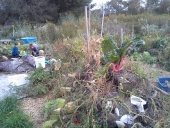








The ultimate goal of farming is not the growing of crops, but the cultivation and perfection of human beings. - Masanobu Fukuoka




Brenda
Bloom where you are planted.
http://restfultrailsfoodforestgarden.blogspot.com/








The ultimate goal of farming is not the growing of crops, but the cultivation and perfection of human beings. - Masanobu Fukuoka












 So far it seems to be working well.
So far it seems to be working well. Idle dreamer




Ludi Ludi wrote:
I'm doing hugelculture because that is all I have the physical energy for. Digging holes and toting logs is enough to keep me busy without adding making charcoal to my list of things to do!So far it seems to be working well.




The ultimate goal of farming is not the growing of crops, but the cultivation and perfection of human beings. - Masanobu Fukuoka





Be kinder than necessary, for everyone you meet is fighting some kind of battle.




Idle dreamer




We burn wood for heat, but I have access to downed cottonwood for hugelbeds. If I put a match to it, it'd be ash in a flash.
Sorry, this biochar is new to me.
The ultimate goal of farming is not the growing of crops, but the cultivation and perfection of human beings. - Masanobu Fukuoka




soil wrote:
actually the biochar is the long run, a few hundred years or more if you practice no till systems. biochar is made to mimic the terra preta soils that the people in the amazon made. amazing stuff if you look it up.
im not bashing hugelkultur beds, i have many of them.




soil wrote:
your not just supposed to burn wood in the open, thats silly. all youll end up with is ash. were making charcoal, as people have done for hundreds and hundreds of years. your heating up organic matter without the presence of oxygen ( in this case wood, but it can be anything even your old clothes ), this way the material turns to pure carbon in form and not into ash, the volatile oils are often captured and can be turned into feul for generators, engines, etc.... big logs would not be good for biochar anyways, the logs would take too much effort into getting the right size for pyrolysis and after for application. its best to use the logs for hugel( old logs fresh wood is too worthy for just letting to rot) and the small side branches, leaves, sticks, etc.. for biochar. the medium sized logs can be saved for firewood if needed.
anything organic can be turned to biochar, thats whats going to make it so amazing successful. waste into biofeul and biochar, which will in turn help grow better crops and sequester carbon for decades. turning fresh raw material into char will only make our situation worse.





Marianne wrote:
Now what?
I would love to have a hugel bed (or 10 or 20), but I'm really worried about termites..they are definitely out here. And now you're saying that I should burn the outside of the wood?
We burn wood for heat, but I have access to downed cottonwood for hugelbeds. If I put a match to it, it'd be ash in a flash.
Sorry, this biochar is new to me.
Sometimes the answer is not to cross an old bridge, nor to burn it, but to build a better bridge.




 Lots of videos to watch and get a feel for how it's done, but not to many doing it in the ground. Seems the my char is better than your char group do the most filming *grin*
Lots of videos to watch and get a feel for how it's done, but not to many doing it in the ground. Seems the my char is better than your char group do the most filming *grin*



 )
)Idle dreamer




 Opinions? Other ideas on how to manage it? Or should I do something else entirely with the bales? Biochar is new to me so thanks for everyone's help!
Opinions? Other ideas on how to manage it? Or should I do something else entirely with the bales? Biochar is new to me so thanks for everyone's help!



The ultimate goal of farming is not the growing of crops, but the cultivation and perfection of human beings. - Masanobu Fukuoka




Idle dreamer





 1
1








The thing about biochar, as I understand it, is that it makes the soil more fertile by making the minerals more accessible to plants but less accessible to leaching as well as providing habitat for soil organisms and that was very appealing. I really don't know if there is much fertility in this soil..there isn't a lot of diversity around, it's almost all black poplar, although along the road allowance there is saskatoon berry, Manitoba maple and such as well. (And various other plants/shrubs I am trying to find someone to help me identify!)
The ultimate goal of farming is not the growing of crops, but the cultivation and perfection of human beings. - Masanobu Fukuoka




Be kinder than necessary, for everyone you meet is fighting some kind of battle.




Ludi Ludi wrote:
We have lots of termites "in the wild" but so far none have gone for the house (12 years). This is even with buried wood under the house (old tree stumps the builder left under there)
Sometimes the answer is not to cross an old bridge, nor to burn it, but to build a better bridge.






Idle dreamer




Be kinder than necessary, for everyone you meet is fighting some kind of battle.













The ultimate goal of farming is not the growing of crops, but the cultivation and perfection of human beings. - Masanobu Fukuoka

|
Arthur, where are your pants? Check under this tiny ad.
GAMCOD 2025: 200 square feet; Zero degrees F or colder; calories cheap and easy
https://permies.com/wiki/270034/GAMCOD-square-feet-degrees-colder
|






